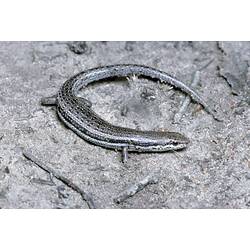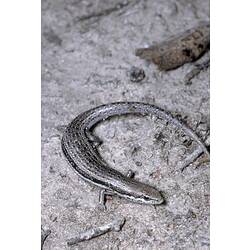General Description
Highly variable in appearance, this skink may be a complex of related species. Variable in colouration and patterning and may exhibit regional differences in body proportions and appearance. Brown to bronze in colour with a tendency towards metallic rose or orange on their underside. Occasionally exhibiting a darker longitudinal stripe on its back and prominent mid lateral stripe. Head indistinct from body and scales behind the eyes fused to form a shield. Usually a band of six rows of wide rough scales across the middle of the back. Head and body length of 6.6 cm.
Biology
Most common 'garden skink' and can often be seen in suburban gardens in large numbers. Secretive in nature, this skink rarely ventures far from cover including vegetation, damp soil and thick leaf litter. Live bearing species, can produce up to eight young depending on the size of the female. Females store sperm in oviducts over winter after mating in autumn. Fertilisation occurs in spring and young are born the following summer.
Distribution
Tasmania and southern Victoria
Habitat
Dry sclerophyll forests, dense forest and alpine heath. Hides in and under dense vegetation, leaf litter, logs and rocks.
More Information
-
Animal Type
-
Animal SubType
-
Brief Id
Highly variable, brown to bronze coloured delicate skink with metallic or rose coloured underside. May have a dark longitudinal stripe.
-
Colours
Brown, Bronze, Rose, Orange
-
Maximum Size
6.5 cm
-
Diet
Carnivore
-
Endemicity
-
Commercial
No
-
Conservation Statuses
CITES: Not listed, FFG Threatened List: Not listed, EPBC Act 1999: Not listed, IUCN Red List: Least Concern
-
Taxon Name
-
Scientific Author
(O'Shaughnessy, 1874)
-
Common Name
Metallic Cool-skink
-
Kingdom
-
Phylum
-
Subphylum
-
Class
-
Subclass
-
Order
-
Suborder
-
Infraorder
-
Family
-
Genus
-
Species Name
metallicus



